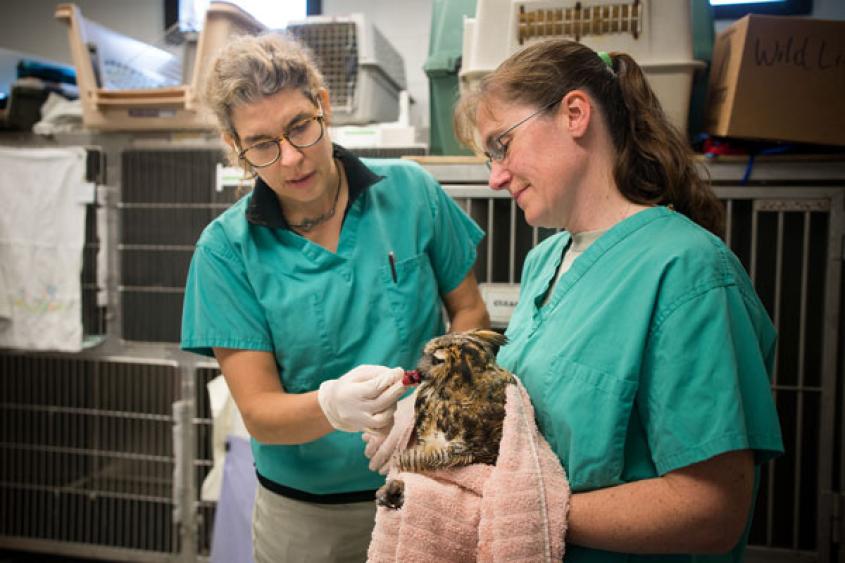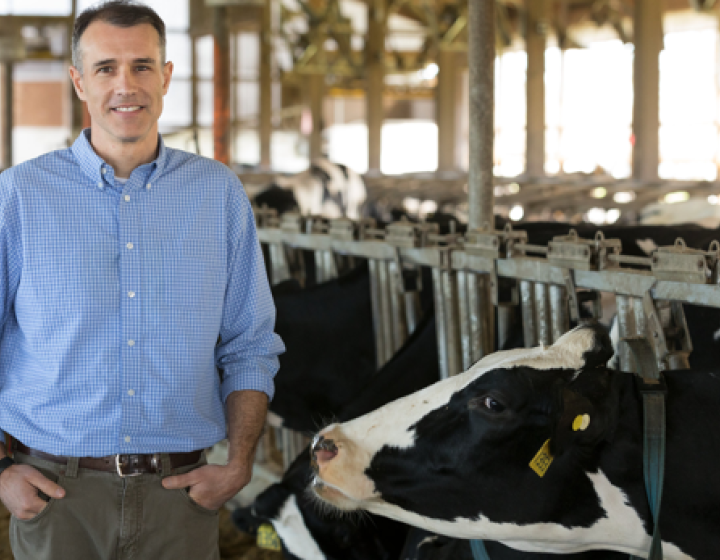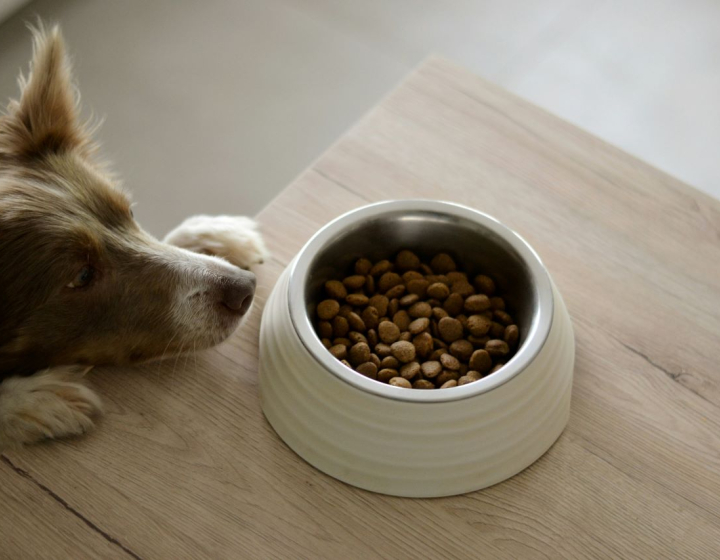Vet techs provide specialized skills and creature comforts at CUHA
The backbone. The lifeblood. The heart. Staff members at the Cornell University Hospital for Animals (CUHA) are fond of anatomical metaphors when describing the indispensible role played by licensed veterinary technicians (LVTs) as part of the CUHA medical team.
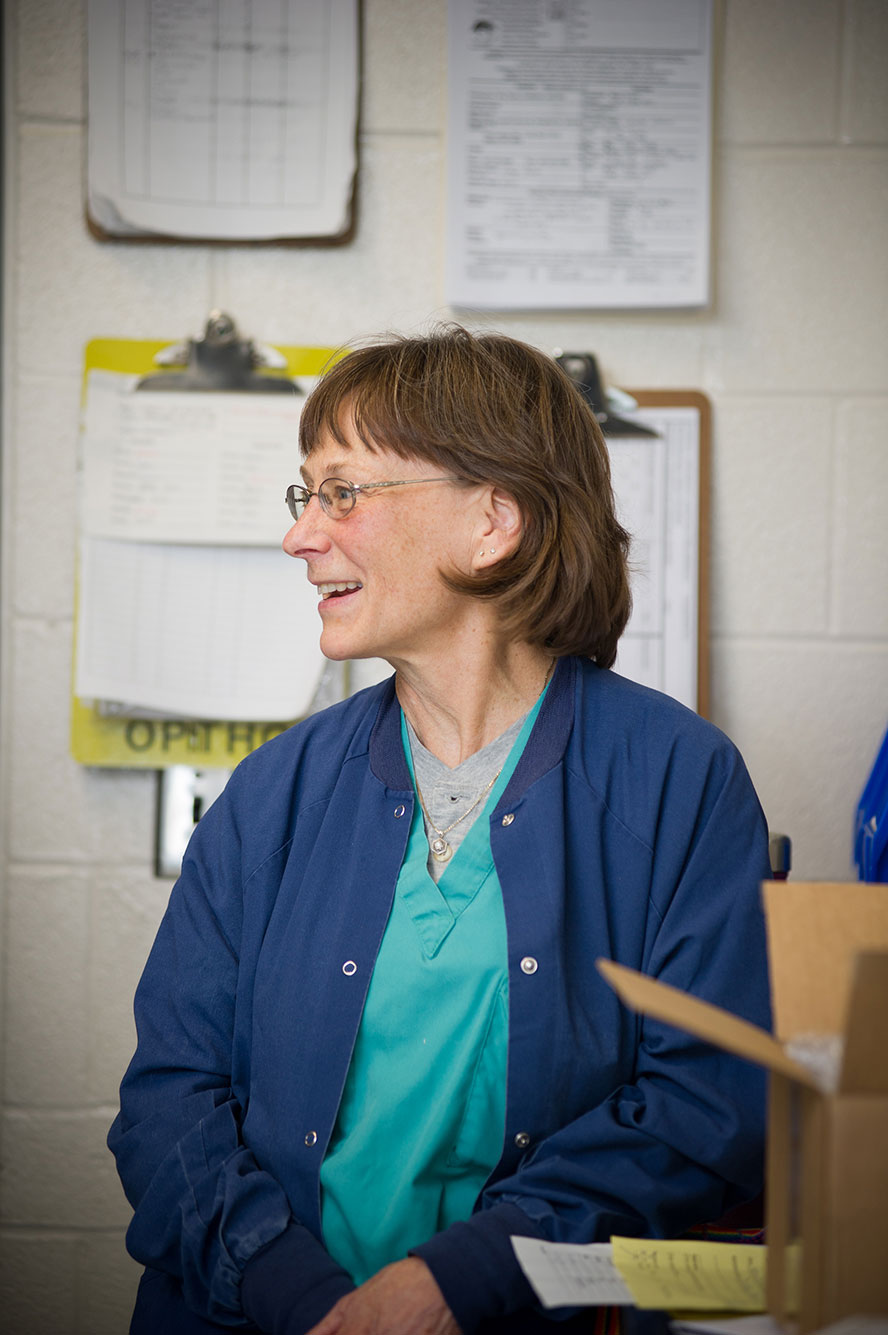 “They’re amazing, and it’s a unique place for them to work,” says Chris Frye, DVM ’11, assistant clinical professor and section chief in sports medicine and rehabilitation. “Our technicians often know more about specific hospital or medical aspects, such as capturing the perfect X-ray. And they have a better metaphorical pulse on the students and some of the patients and clients as they are vital extensions of our hands, eyes and ears. They can be where we aren’t and they can do what we often can’t.”
“They’re amazing, and it’s a unique place for them to work,” says Chris Frye, DVM ’11, assistant clinical professor and section chief in sports medicine and rehabilitation. “Our technicians often know more about specific hospital or medical aspects, such as capturing the perfect X-ray. And they have a better metaphorical pulse on the students and some of the patients and clients as they are vital extensions of our hands, eyes and ears. They can be where we aren’t and they can do what we often can’t.”
LVTs are a versatile resource for behind-the-scenes support as well as the frontline of service. They assist everyone in the hospital, whether faculty, house officers or each other. They train and mentor veterinary and technician students. They order supplies, schedule medical procedures and manage the day-to-day logistics that keep the hospital running smoothly and free up doctors to see more patients. And LVTs are often a source of great comfort for clients bringing in an injured or ailing patient.
“CUHA has an amazing crew of dedicated licensed veterinary technicians with specialty positions in everything from my world of imaging to wildlife,” says Dr. Meg Thompson, assistant dean for hospital operations and director of CUHA. “Amongst their many talents, they run our MRI, take care of our endoscopes, keep our patients safe during anesthesia and know how to handle 900-lb pigs for medical procedures.”
“We’re doing laundry one minute, and hand-feeding owls the next”
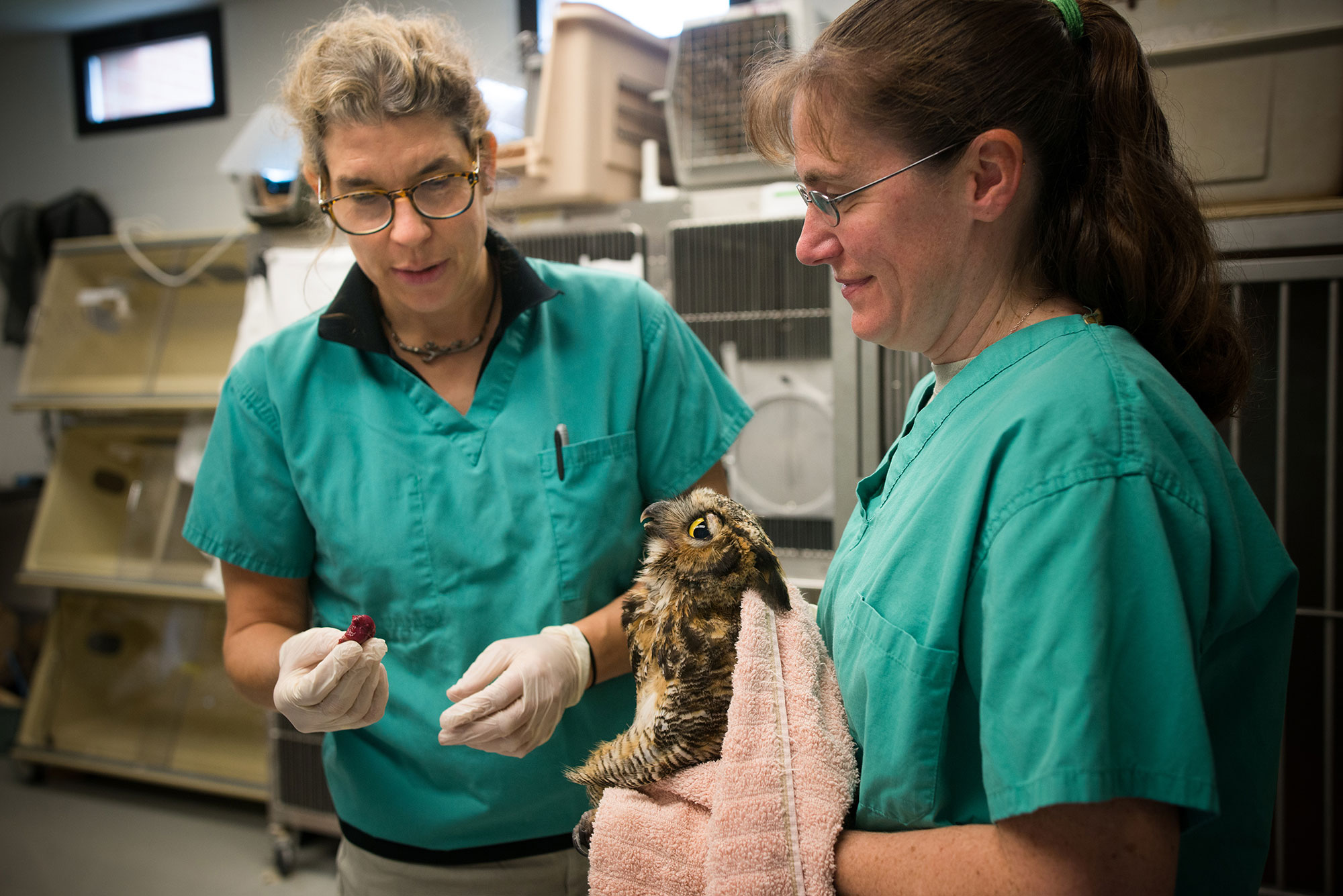 From bobcats and bald eagles to woodchucks and mink, the Janet L. Swanson Wildlife Health Center sees an eclectic array of injured native animals that have been found by concerned members of the public. With a small staff and an off-campus location, LVTs Alice VanDeMark and Tina Hlywa have their hands full caring for an ever-changing assortment of regional wildlife. A recent visit found VanDeMark hand-feeding pieces of rat—which she had cut up herself earlier that morning—to a great horned owl that had suffered head trauma after apparently being struck by a vehicle.
From bobcats and bald eagles to woodchucks and mink, the Janet L. Swanson Wildlife Health Center sees an eclectic array of injured native animals that have been found by concerned members of the public. With a small staff and an off-campus location, LVTs Alice VanDeMark and Tina Hlywa have their hands full caring for an ever-changing assortment of regional wildlife. A recent visit found VanDeMark hand-feeding pieces of rat—which she had cut up herself earlier that morning—to a great horned owl that had suffered head trauma after apparently being struck by a vehicle.
“We do everything up here, from going outside to harvest earthworms to mopping the floors,” VanDeMark says. “We have to know the husbandry of all these animals. They have specific diets, they have to be handled differently. The cool thing is we do so many different things: radiology, prepping for surgery, anesthesia, cleaning the instruments. We’re doing laundry one minute, and chopping up rats the next. And we’re talking to the public all the time. ‘There’s a snapping turtle laying eggs in my yard, what do I do?’ We troubleshoot all those phone calls. People are so grateful that we’re here and we can help them.”
Training students and offering specialized support
While the “jack-of-all-trades” model remains popular in general veterinary practices, many LVTs at CUHA are more focused in their duties, especially those who are certified for a specific field. A little more than ten years ago, LVT Karen Basher became certified in anesthesia, and she now oversees 10 to 15 anesthetics a day. Much of her role involves observing the third- and fourth-year students from Cornell University College of Veterinary Medicine who cycle through the hospital in two-week rotations. The students administer and monitor anesthesia while Basher follows closely along, offering guidance and stepping in to assist when needed.
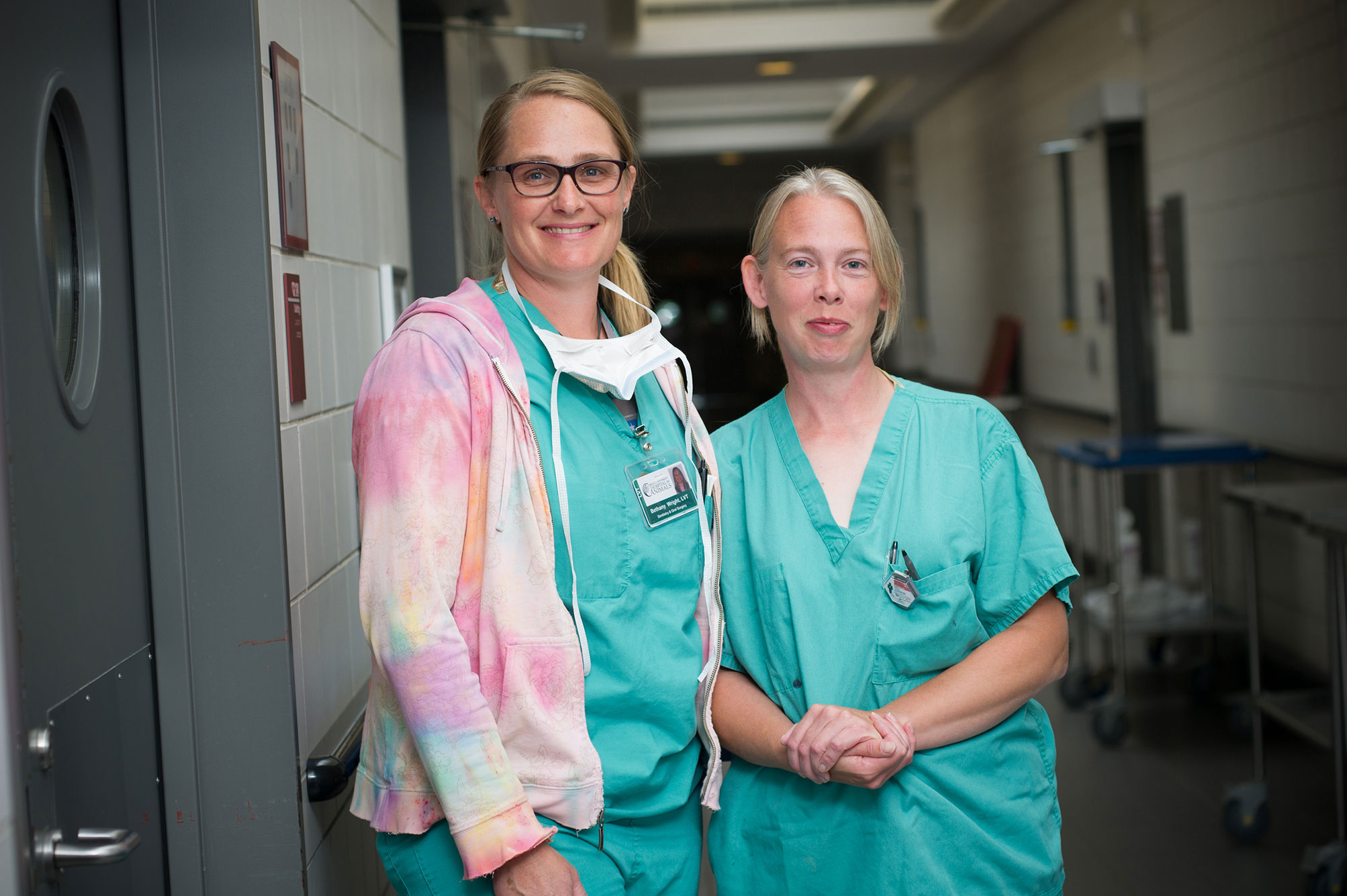 “I really enjoy watching the light bulbs go off in the students’ heads when they finally put it all together,” Basher says. “Everything they learned in their books, they’re actually getting the concepts and understanding what they’ve read and making that connection.”
“I really enjoy watching the light bulbs go off in the students’ heads when they finally put it all together,” Basher says. “Everything they learned in their books, they’re actually getting the concepts and understanding what they’ve read and making that connection.”
Training and mentoring students is an essential part of many LVTs’ day-to-day responsibilities, and the students are grateful for the support.“We couldn’t do this without them,” says Nathaniel Violette, a fourth-year student who was recently working in the companion animal ICU. “The LVTs are always willing to teach us. They know all the technical subtleties of dealing with difficult, critical patients. They have years of clinical experience. I learn a lot from them every day.”
Evolving roles
LVTs are also able to function as liaisons between the students and the clinicians. Dr. Norm Ducharme, professor and staff surgeon in the large animals section of the Equine and Farm Animal Hospitals, says that students can often be intimidated working with surgeons but LVTs are more approachable, almost as peers. At the same time, LVTs are equally at ease interacting with doctors.
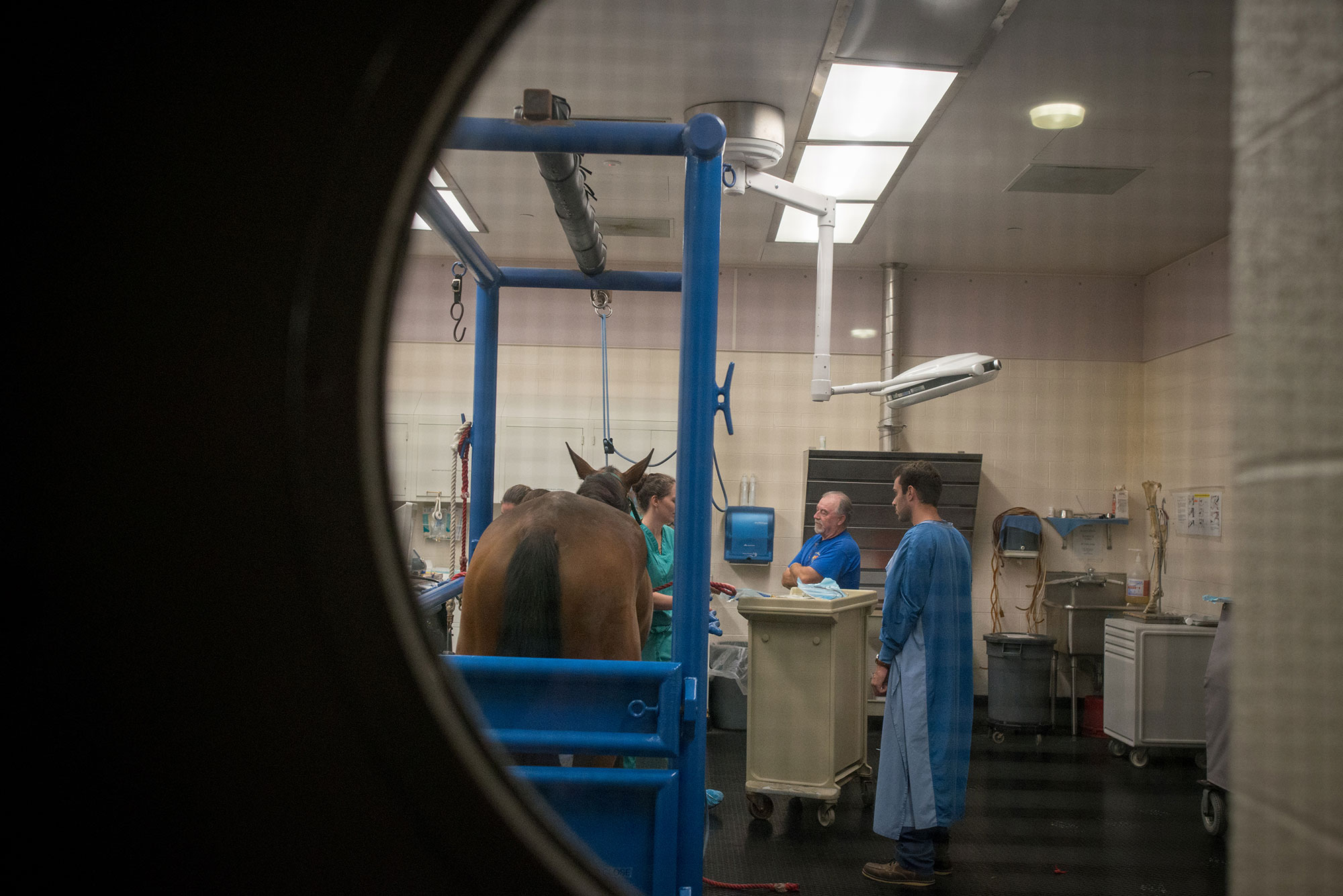 “It’s very collegial,” Ducharme says. “LVTs are very comfortable to tell you, ‘Hey, what do you think of this horse? I think he’s a little more swollen.’ We encourage our technicians to be free to tell us what they think medically as well as discussing the needs of students. Their professional role, the depth and quality, has changed a lot through the years as the level of care has increased, the degree of complication has increased. The types of procedures we do are a lot more sophisticated, so they have more nuance.”
“It’s very collegial,” Ducharme says. “LVTs are very comfortable to tell you, ‘Hey, what do you think of this horse? I think he’s a little more swollen.’ We encourage our technicians to be free to tell us what they think medically as well as discussing the needs of students. Their professional role, the depth and quality, has changed a lot through the years as the level of care has increased, the degree of complication has increased. The types of procedures we do are a lot more sophisticated, so they have more nuance.”
Erin Winland has been an LVT for 15 years and has worked in the sports medicine section at CUHA for the last year and a half. Her daily routine includes assisting with consultations and conducting physical therapy services for dogs that are suffering from arthritis and other mobility issues, or recovering from surgery. She agrees the role of LVTs has evolved. “When I first started my career there were a lot more old-school veterinarians who thought you were just there to hold an animal. That’s all you did,” Winland says. “Now I find the doctors rely more on their technicians, they trust them more to get the job done. Some doctors don’t even need to tell their technicians to do something. It’s more of a symbiotic relationship. They know what needs to be done and they do it together.”
A lifeline for animals, every hour, every day
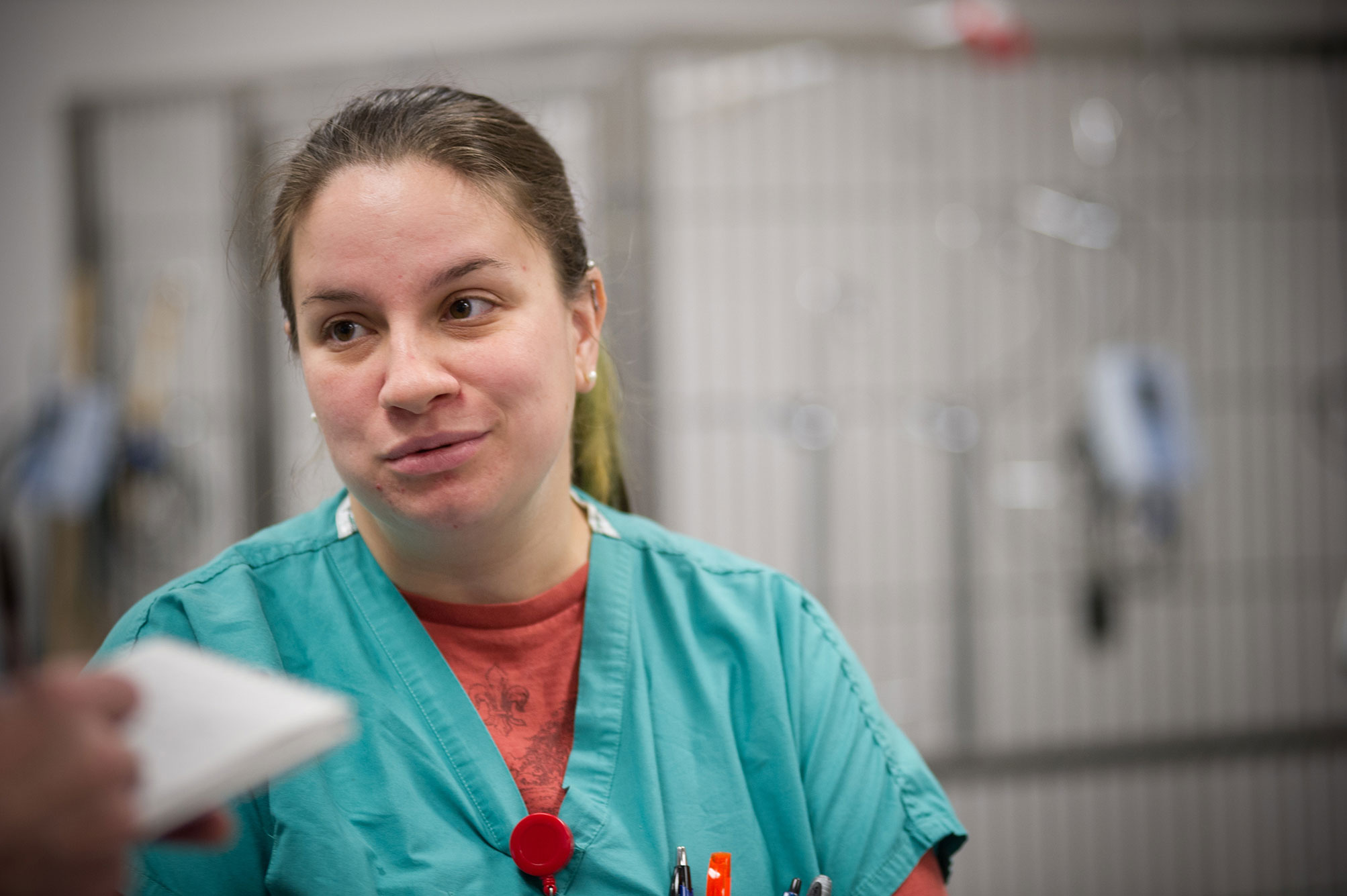 One thing that hasn’t changed over the years is the consistency of service and stability for the hospital that LVTs provide. Clinicians and students rotate, residents come and go. But LVTs are a steady presence, preserving so much vital institutional memory. Nowhere is this stability more apparent than the LVTs who work at night, ensuring that there is constant 24/7 care for the CUHA patients that could not survive without it.“We are a lifeline for the pet, between them and the clinician,” says Ashley Wood, an LVT who works overnight in the companion animal ICU. “Without us, it would be impossible to hospitalize these animals, especially the very, very ill ones. They need at least hourly treatments. They’re on oxygen, they’re on electrocardiographic monitoring, and in the most serious cases they’re being mechanically ventilated. You really would not be able to keep these patients well-cared for without the dedicated people who work every hour in the day to assist with these varied needs.”
One thing that hasn’t changed over the years is the consistency of service and stability for the hospital that LVTs provide. Clinicians and students rotate, residents come and go. But LVTs are a steady presence, preserving so much vital institutional memory. Nowhere is this stability more apparent than the LVTs who work at night, ensuring that there is constant 24/7 care for the CUHA patients that could not survive without it.“We are a lifeline for the pet, between them and the clinician,” says Ashley Wood, an LVT who works overnight in the companion animal ICU. “Without us, it would be impossible to hospitalize these animals, especially the very, very ill ones. They need at least hourly treatments. They’re on oxygen, they’re on electrocardiographic monitoring, and in the most serious cases they’re being mechanically ventilated. You really would not be able to keep these patients well-cared for without the dedicated people who work every hour in the day to assist with these varied needs.”
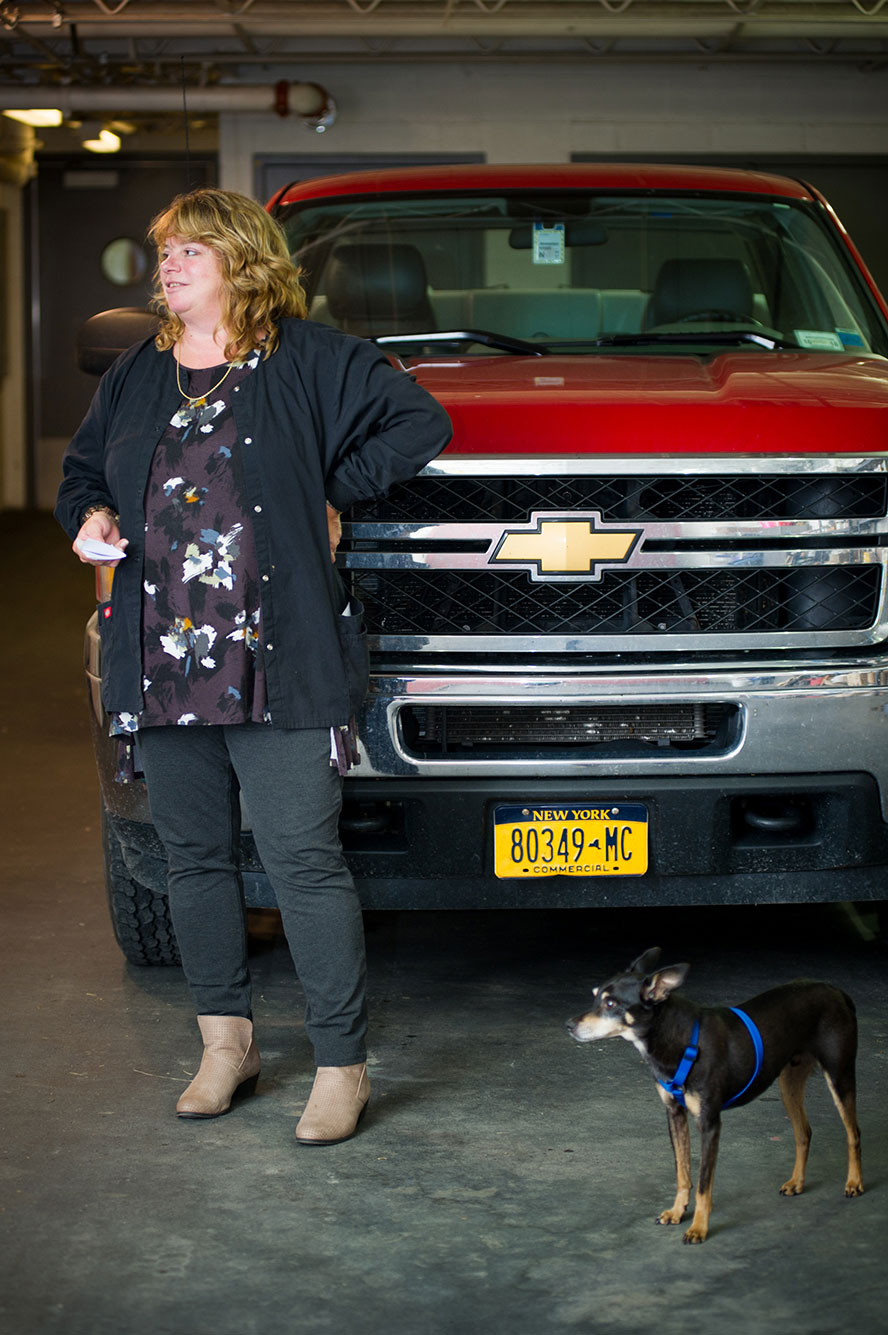 And as LVTs are unabashed animal lovers, the perks of the job are pretty great.“There’s so many cool things we get to see,” says Katie Stevens, an LVT with the large animal surgery suites. “I really love the science of surgery and seeing inside the animals. And I love working with horses. And cows. And goats. And sheep. And pigs.”
And as LVTs are unabashed animal lovers, the perks of the job are pretty great.“There’s so many cool things we get to see,” says Katie Stevens, an LVT with the large animal surgery suites. “I really love the science of surgery and seeing inside the animals. And I love working with horses. And cows. And goats. And sheep. And pigs.”
--By David Nutt



